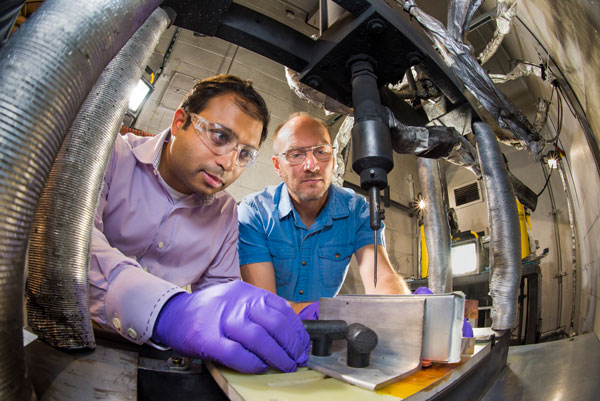Sandia, University of Michigan investigating materials to expedite vehicle battery-charging rates
A key roadblock to the widespread use of long-range electric vehicles — the longer time needed for a complete recharge compared to a gas station fill-up — may soon be overcome, thanks to DOE support for extreme fast-charging battery research.
Fueled by a $1.5 million award from DOE’s Vehicle Technology Office, Sandia and the University of Michigan have teamed up to develop engineered battery materials that can be charged in less than 10 minutes.
Fast-charging battery research aims to reduce the time gap between gas and electric vehicles by developing advanced anodes, electrolytes and battery cell designs that can be charged rapidly while maintaining performance over at least 10 years. Sandia and University of Michigan researchers are overcoming fast-charge challenges at the material level by enhancing a battery’s anode — the storage hub for lithium ions during the charging process — to store lithium ions more quickly, which translates to faster charge rates.
The project is one of several announced to help advance DOE’s research on batteries and electrification by reducing battery pack costs to less than $100 per kilowatt-hour, increasing range to more than 300 miles and reducing charging time to less than 15 minutes by 2028.

“It’s a great opportunity for Sandia to use our expertise in battery and advanced power source research to help accelerate vehicle battery-charging rates,” said Chris Orendorff, senior manager of Sandia’s Power Sources Technology Group.
For this project, Sandia will contribute advanced prototype characterization and diagnostic capabilities, while the university will contribute key electrode modification know-how. The University of Michigan Battery Lab, a user facility for scaled-up battery prototype fabrication, will also play a key role in the project.
Addressing a key roadblock
“The underlying goal of fast-charging research is to address a key roadblock to consumer adoption of electric vehicles — the user experience during charging,” said Mohan Karulkar, the lead Sandia researcher for the project. “We are all accustomed to ten-minute trips to the gas station, but we aren’t there yet with long-range electrical vehicle charging. Fast charging is how you bridge that gap.”
However, Mohan noted that faster charge times come at a cost.
“Increasing charge current lowers the charge time, but it puts additional stresses on the battery,” he said. “This project aims to address this issue by making materials that are better equipped to handle fast charge rates.”
Specifically, researchers are planning novel modifications to existing anode materials to allow faster lithium ion storage, leading to higher charge rates and less stress on the battery.
“We will conduct this research without using exotic new materials. Instead, we will engineer the anode — a cost-effective, measurable and achievable objective,” Mohan said. “If successful, we’ll be one step closer to 10-minute charge times and clearing the way for large-scale electric vehicle adoption.”
Mohan compared battery charging to rainfall in the desert.
“Rain in Albuquerque tends to lead to flooding because so little rain falls throughout the year,” he said. “The faster the rain falls, the worse the flooding because the ground is simply too compact to adsorb the water, even though the soil is incredibly dry and thirsty.”
He said the fast-charging battery project is like building tiny channels into the ground to help water adsorb faster, while also applying special coatings on the ground to keep water in place and prevent it from running off and pooling.
“In this analogy, the ground is the battery’s anode, and the raindrops are lithium ions,” Mohan said. “The flooding of water is akin to a key failure mechanism during a fast-charge attempt. Lithium piles up on the anode surface instead of being adsorbed into it.”
Improving battery-charging techniques
Sandia and the University of Michigan are collaborating to improve battery-charging techniques. As university researchers apply various techniques to increase lithium adsorption into the anode, the Sandia team will assess the resulting changes in charging rates, which will lead to further rounds of research.
The science behind improving charge rates faces several challenges. Experimental timeframes become much shorter when the target charging time decreases. To accurately measure electrochemical phenomena during rapid experiments, Sandia will employ high-precision and high-speed analysis tools to understand how batteries are damaged at high rates and how modifications might mitigate those damage mechanisms.
The Sandia team brings a depth of experience in the area of battery charge improvements. Prior to joining Sandia, Mohan spent a decade in the auto industry working to develop electric-vehicle batteries. He is excited to see the advances made by Sandia and the University of Michigan feed back into the commercial sector.
“Once we demonstrate successful techniques for creating fast-charging batteries, further work will be needed to expand the battery improvements to the scale of commercial automotive batteries,” Mohan said.
He said the development of new battery-charging techniques will be coordinated with other Sandia efforts, such as research on heat management and electricity delivery to deliver complete fast-charging solutions.
“Our group isn’t working in a vacuum,” Mohan said. “We will leverage resources from throughout Sandia to make the biggest impact possible.”
See related story on Sandia’s new Battery Test Facility.